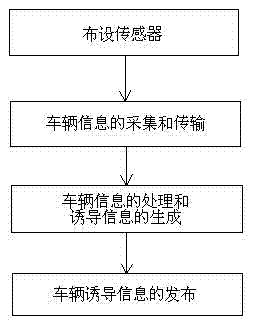Intelligent induction method of expressway toll station
A technology for expressways and toll booths, applied in ticketing equipment, instruments, etc., to solve problems such as reduced traffic capacity, difficult management, queues in lanes, and no vehicles in other lanes.
- Summary
- Abstract
- Description
- Claims
- Application Information
AI Technical Summary
Problems solved by technology
Method used
Image
Examples
Embodiment 1
[0027] Embodiment 1: Assuming that there are five lanes in total at the toll booth, wherein the first to third lanes are ordinary lanes, the height limit is 2.5 meters, the width limit is 2.5 meters, and the length limit is 5.5 meters; the fourth lane is a medium-sized vehicle lane, The height limit is 3.5 meters, the width limit is 3.5 meters, and the length limit is 10 meters. The fifth lane is an ultra-high, ultra-wide, and ultra-long lane, with a height limit of 5 meters, a width limit of 5 meters, and a length limit of 20 meters; The car with the brand name XXXXXX1, 1.455 meters high, 1.811 meters wide, and 4.624 meters long drove to the gantry two kilometers away from the toll booth. At this time, the lane congestion recognition sensor installed between the toll booth and the gantry The measured queuing of 5 vehicles at the first lane, the queuing distance is 28 meters, the queuing of 8 vehicles at the second lane, the queuing distance is 42 meters, the queuing of 6 vehic...
Embodiment 2
[0028] Embodiment 2: assuming that there are five lanes in total at the toll booth, wherein the first to third lanes are ordinary lanes, the height limit is 2.5 meters, the width limit is 2.5 meters, and the length limit is 5.5 meters; the fourth lane is a medium-sized vehicle lane, The height limit is 3.5 meters, the width limit is 3.5 meters, and the length limit is 10 meters. The fifth lane is an ultra-high, ultra-wide, and ultra-long lane, with a height limit of 5 meters, a width limit of 5 meters, and a length limit of 20 meters; The car with the brand name XXXXXX2, 1.455 meters high, 1.811 meters wide, and 4.624 meters long drove to the gantry two kilometers away from the toll booth. At this time, the lane congestion recognition sensor installed between the toll booth and the gantry It is measured that 9 vehicles are lined up in the first lane, and the queuing distance is 48 meters; 8 vehicles are lined up in the second lane, and the queuing distance is 42 meters; 11 vehi...
Embodiment 3
[0029]Embodiment 3: assuming that there are five lanes in total at the toll booth, wherein the first to third lanes are ordinary lanes, the height limit is 2.5 meters, the width limit is 2.5 meters, and the length limit is 5.5 meters; the fourth lane is a medium-sized vehicle lane, The height limit is 3.5 meters, the width limit is 3.5 meters, and the length limit is 10 meters. The fifth lane is an ultra-high, ultra-wide, and ultra-long lane, with a height limit of 5 meters, a width limit of 5 meters, and a length limit of 20 meters; The car with the brand name XXXXXX3, 2.5 meters high, 2.5 meters wide, and 8 meters long drives to the gantry two kilometers away from the toll booth. At this time, the lane congestion recognition sensor installed between the toll booth and the gantry The measured queuing of 5 vehicles at the first lane, the queuing distance is 28 meters, the queuing of 8 vehicles at the second lane, the queuing distance is 42 meters, the queuing of 6 vehicles at t...
PUM
 Login to View More
Login to View More Abstract
Description
Claims
Application Information
 Login to View More
Login to View More - R&D
- Intellectual Property
- Life Sciences
- Materials
- Tech Scout
- Unparalleled Data Quality
- Higher Quality Content
- 60% Fewer Hallucinations
Browse by: Latest US Patents, China's latest patents, Technical Efficacy Thesaurus, Application Domain, Technology Topic, Popular Technical Reports.
© 2025 PatSnap. All rights reserved.Legal|Privacy policy|Modern Slavery Act Transparency Statement|Sitemap|About US| Contact US: help@patsnap.com

